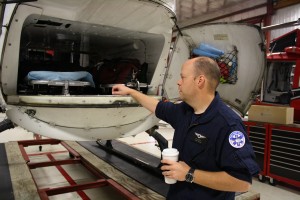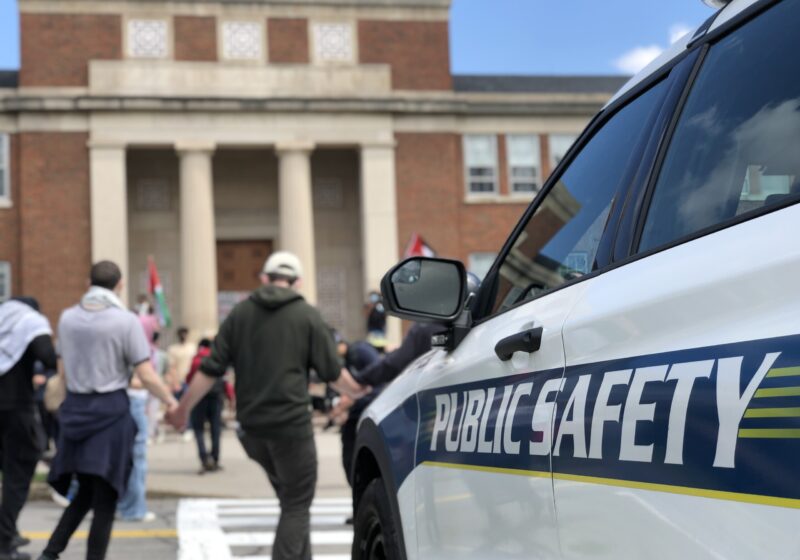With their sirens blaring day and night, it can be hard to ignore the ambulances constantly rushing to Strong Memorial Hospital. But what you probably haven’t paid attention to — unless you witnessed an accident or perhaps saw footage of the helicopters on the news — are the men and women of Mercy Flight Central.
These protectors from above spend 60 percent of their time on the job flying to worst-case scenarios — strokes, heart attacks and severe accidents. With three rotor-wing helicopters (including their new MBB/Kowasaki BK 117) and two fixed-wing airplanes, MFC responds to on-scene medical emergencies, hospital-to-hospital transports and between-state transports.
Back in the early 1990s, CEO Paul Hylan founded this operation, in Canandaigua, using his background in military aviation and firefighting to create Mercy Flight Central — giving the northern New England region the aerial medical service that it was missing.
“Ninety-nine percent of [the flight control programs] were hospital aligned, and nobody in the Rochester area wanted to come on board as a hospital, so I just ended up doing it myself,” Hylan said. “I basically mortgaged the farm and everything I had and put all my efforts into this. It’s been a labor of love from the get-go.”
And the labor of love has paid off — MFC has transported over 10,000 patients since its inception in November 1991.
While the helicopters are the most visible extensions of MFC, the crew is the lifeblood of the organization. Between calls, the flight crew — including one pilot, one nurse and one paramedic — waits on standby, acting as a complete unit even though they each have their own important responsibilities.
The nurse and paramedic must act together for each patient. With a complete emergency room in a space the size of a small closet, they must fly together to assure the patient’s safety.
“It’s important to get along with who you work with,” flight paramedic Scott Popowich said. “You have to trust them with your life.”
The pilot, who has usually had military training, is another quintessential facet of the crew, whose job begins even before take-off as the voice of the flight. He or she must account for the weather, visibility and other factors to make sure the flight is feasible and to make sure they aren’t putting themselves at risk by flying.
Of paramount importance for the crew members is being up-to-date on the new medicines and drugs that are available in the field.
Their knowledge is crucial in those moments when the patient is in the air, struggling between life and death — something that’s always on the minds of the crew.
With the pilots, nurses and paramedics on 24-hour shifts, they often pass their downtime discussing new trends in medicine and sharing their areas of expertise with their peers.
“Everyone comes from a varied background,” flight nurse Kevin Smith said. “We are always learning.”
But learning about new medicines isn’t the only way that the Mercy Flight Crew spends what can be hours between calls.
“I have this thing,” Popowich admitted. “Every morning from 8 -10 a.m., I watch ‘The Golden Girls.’”
Even when “The Golden Girls” isn’t on, everyone at Mercy Flight acts as a family — cooking dinner and joking together — as the base becomes their home away from home for the day.
But when three beeps and an announcement from the operator signal a potential call, all joking ceases. The crew knows how serious the situation is.
When the helicopter takes off, the well-oiled machine that is MFC shows what it is made of. The call starts with the communication specialists, who are in constant connection with the helicopter and ground units, relaying information and plotting out flight plans.
En route to the patient, the show belongs to the pilots, who have the ability to transport patients in less than half the time that an ambulance would require. While they do have several designated landing zones around upstate New York, they can land pretty much anywhere that has enough space. This includes on roads, parking lots and even openings in the woods.
Once the pilot touches down, the nurse and paramedic teams go to work. On scene they become the patient’s primary medical team. They stabilize the patient and assess if he or she are mentally fit enough to take one of the scariest trips of his or her life. The last thing they want is a patient thrashing around in midair, but if necessary they have plenty of sedatives on hand.
The time from the scene to the hospital can be the most critical, not just for the patient’s physical well-being but also for his or her mental well-being.
“If you are in tremendous pain, you have a better chance of getting post traumatic stress disorder,” flight paramedic Winnie Romeril said.
In the midst of providing care, the crew is also there to reassure and calm their patient in his or her most trying time. While the patient in the air, his or her life is in the hands of the MFC crew, which goes above and beyond to make sure that the patient makes it to the hospital in the best condition possible.
It takes a certain type of person to be able to handle 24-hour shifts, stresses of flights and the thrills of success, but the MFC crew wouldn’t have it any other way.
“[We have] Type A personalities,” Director of Operations James Mizerak said of his crew. “[We’re] always running.”
Manrique is a member of the class of 2012.


